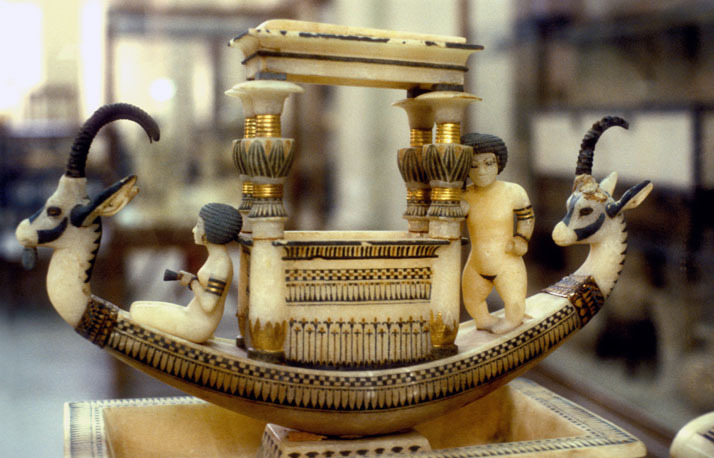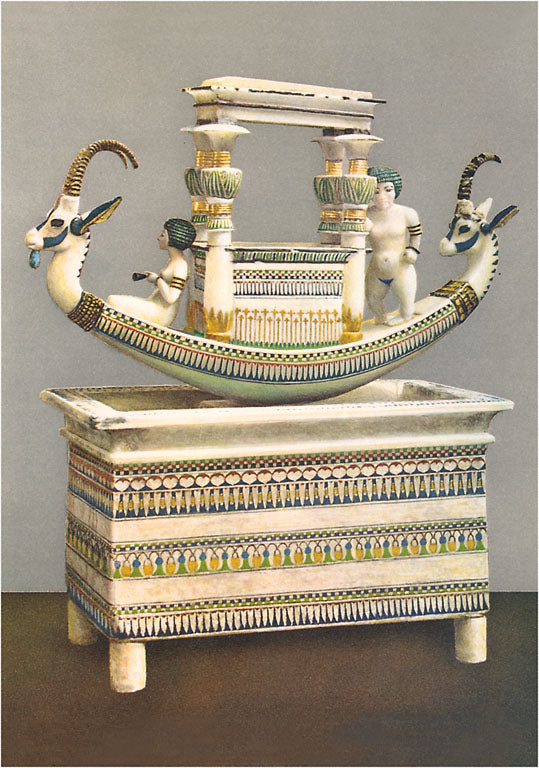Table of Contents
ToggleA Remarkable Discovery
One of the most exquisite artifacts from ancient Egypt, Tutankhamun’s alabaster boat, offers an extraordinary glimpse into both the artistic mastery and the spiritual beliefs of the time. Discovered in 1922 by British archaeologist Howard Carter during his historic excavation of Tutankhamun’s tomb (KV62) in the Valley of the Kings, this stunning model was one of many treasures found buried with the boy pharaoh. Crafted during his reign, which spanned from 1332 to 1323 BC, the alabaster boat remains a captivating testament to the Egyptians’ understanding of both life and the afterlife.

The Craftsmanship of Alabaster
The boat is carved from a single piece of alabaster, a translucent, fine-grained variety of gypsum. Its gleaming surface, smooth finish, and intricate design highlight the skill of Egyptian artisans. Measuring approximately 45 cm in length, the boat has a flat bottom with gently raised sides, replicating the sleek, practical design of Egyptian river vessels. These vessels were used to navigate the Nile, Egypt’s lifeblood, making the boat a symbolic object that connected daily life with profound spiritual meaning.

This exceptional craftsmanship is not only a display of the artistic sensibilities of ancient Egyptian culture, but also demonstrates their technical skill in working with such materials. Alabaster, prized for its beauty and durability, was frequently used in the creation of objects meant to accompany royalty on their journey to the afterlife, underscoring the significance of this boat as both an artistic and religious artifact.
Symbolism in Egyptian Mythology
Boats held special importance in Egyptian mythology. They were believed to serve as vessels for transporting souls through the afterlife, enabling the deceased to journey alongside gods such as Ra, the sun god, and Osiris, the god of the underworld. This alabaster boat is no exception, symbolizing Tutankhamun’s journey to the afterlife, ensuring his safe passage through the realms of the dead.

The inclusion of such a boat among the treasures in Tutankhamun’s tomb reflects the importance of watercraft in ancient Egyptian funerary practices. It also highlights the Egyptians’ view of the afterlife as a continuation of the physical world, where elements from daily life, like boats, had spiritual counterparts that aided the soul’s transition.
A Glimpse into Ancient Beliefs
The spiritual significance of Tutankhamun’s alabaster boat makes it more than just a work of art; it provides insight into the ritualistic and religious traditions of ancient Egypt. Boats were symbols of protection, mobility, and divine favor, representing the soul’s ability to traverse the waters that separated the realms of the living and the dead. The boat’s inclusion in the tomb suggests that the pharaoh, even in death, would have all the tools necessary to navigate the afterlife.

This model also exemplifies the fusion of art and spirituality in Egyptian culture, where the functional and the sacred were closely intertwined. Every detail of the boat—from its material to its craftsmanship—was deliberately chosen to ensure that it would fulfill its sacred purpose.
Conclusion
The alabaster boat found in Tutankhamun’s tomb is a true masterpiece of ancient Egyptian craftsmanship, serving not only as an artistic marvel but also as a powerful symbol of the pharaoh’s passage to the afterlife. Preserved in the Egyptian Museum in Cairo, this artifact continues to captivate scholars and visitors alike, offering a unique window into the artistic, religious, and cultural practices of a civilization that remains one of history’s greatest legacies. The boat’s fine craftsmanship, symbolic meaning, and role in Egyptian funerary rites make it one of the most compelling artifacts from the tomb of the boy king.

